5G-Trials workshop at IEEE 5G World Forum
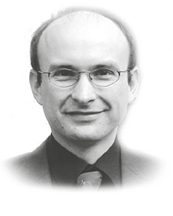
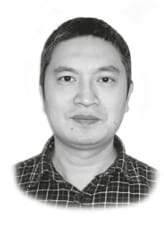
Uwe Herzog Tao Chen
Eurescom VTT
herzog(at)eurescom.eu tao.chen(at)vtt.fi
On 1st October 2019, the “2nd Workshop on 5G-Trials – From 5G Experiments to Business Validation” took place in Dresden. It was part of the IEEE 5G World Forum in Dresden from 30th September to 2nd October 2019. The workshop was jointly organised by the 5G PPP projects 5G-DRIVE, 5G EVE, 5G-VINNI, 5GENESIS, and SLICENET.
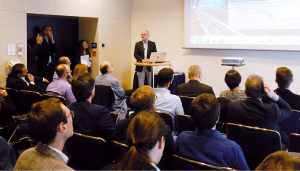
Keynote speaker Michael Meyer from Ericsson
At the current stage of 5G evolution, the design phase has been successfully completed, the first set of standards has been released, and the commercial rollout has started. In this context, a large number of 5G trials are currently being conducted around the globe. According to IDATE DigiWorld statistics from June 2019, 153 5G trials are currently taking place in the 28 EU Member States. The 5G-Trials workshop provided a forum for industry and academics to disseminate new findings on 5G trials and new business development.
The workshop was sponsored by five 5G PPP projects. They included, among others, the three projects that are currently building experimental 5G infrastructures, which will be offered for experimentation to vertical industries for testing innovative 5G applications. From that perspective the organisers are well connected in the 5G community and were successful in distributing the call for papers for this workshop. With 14 paper submissions received, this workshop was ranked number 3 among all workshops. Due to the high quality of papers, 9 out of the 14 papers were accepted. The paper presentations together with two invited keynote speeches and two panel discussions filled a long and interesting day for the about 40-50 workshop attendees.
5G trials in Europe
In the welcome talk, an overview was given of 5G trialling activities in Europe and showed some statistics e.g. in terms of trials per country, spectrum usage, the participation by vertical sectors in 5G trialling activities and the size of larger trials and first 5G roll-outs around the globe. Media and Entertainment is the sector in which most 5G trials are currently performed, followed by Transport and Automotive.
In the first keynote speech, Michael Meyer from Ericsson gave his view on “Experiencing 5G in early trials”. He said that 5G is being propelled by three areas – massive machine-type communications, critical machine-type communications, and Enhanced Mobile Broadband, where the use cases will be diverse, ranging from Haptic Healthcare to driverless buses and fibre-equivalent residential access. Ericsson’s 5G radio and core testbeds have evolved to include an increasing number of 5G features. Trials are being performed in both below 6 GHz but also in mm-wave bands. In the speaker’s view, 5G industry trials are important to explore the digital transformation of different industries, and to demonstrate the value of 5G, which he explained by using examples from the mining industry, connected mobility, and connected adaptive production.
In the first paper session, three papers with results related to the 5G PPP trial infrastructure projects were presented. These projects build 5G infrastructures for the large-scale trials carried out by other 5G PPP projects. The first paper, presented by Giada Landi from Nextworks, introduced the experimental architecture developed in 5G EVE, and explained the experimental workflow to be used by other projects. The next paper, presented by Anastasius Gavras from Eurescom, introduced the trial infrastructure of the 5G-VINNI project. 5G-VINNI aims to provide infrastructure as a service to other projects. He explained the conceptual architecture, technical areas covered by the project, and the testing capability of the facility. The third paper was also from 5G-VINNI, but it focused on the business aspect of the project. It explained the strengths, weaknesses, opportunities and threats (SWOT) analysis of the 5G-VINNI facility.
Use of 5G by verticals
In the second keynote, Panagiotis Demestichas from University of Piraeus presented the 5G Pan-European Trials Roadmap which is being prepared by the 5G Infrastructure Association’s 5G Trials Working Group. The presentation provided ample details of ongoing and planned 5G trialling activities in Europe. He also informed the audience about an informative brochure on selected 5G trials and pilots being undertaken by 5G PPP projects. The brochure can be downloaded from the 5G PPP website.
The second paper session was related to the use of 5G technologies for verticals. Two papers were presented. The first paper, presented by Mikko Uusitalo from Nokia, introduced how ultra-reliable and low-latency communication (URLLC) services can be applied to the automation of harbours. The paper investigated, if the latency of 5G networks can satisfy the remote-control needs of crane operation. The second paper, presented by Mark Roddy from Cork Institute of Technology, introduced the network slicing results from the SliceNet project. It showed how the combination of network slicing and edge computing can support the emergency use case of stroke patients in an ambulance.
The third paper session focused on the evaluation of three 5G use cases. The first paper examined 5G solutions for the media and entertainment industry. Presented by Giuseppe Caruso from Engineering Ingegneria Informatica, the paper introduced three 5G business scenarios in the media industry. It explained also how 5G may affect business relationships of stakeholders in the media industry. The second paper, presented by Eleanor Davies from Lancaster University, presented the performance measurement of a fixed wireless broadband system based on TV white space and millimetre wave in rural areas of UK. It showed that TV white space has potential for stable broadband services in rural areas, while the millimeter wave has limitations due to line-of-sight constraints in irregular terrain. The third paper dealt with the 5G tourism use cases. Konstantinos Katsaros from Digital Catapult presented how 5G technologies can support an augmented reality tour of ancient Roman baths. The 5G key technologies used in the test include multi-access edge computing (MEC) for remote rendering, network slicing, and software defined networking (SDN).
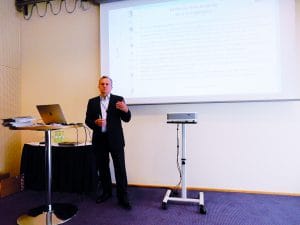
Keynote speaker Panagiotis Demestichas from University of Piraeus
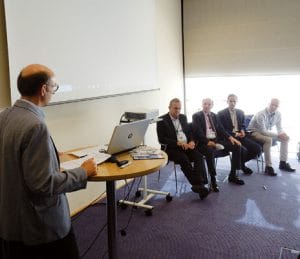
Panellists of the first panel session on Results from 5G Trials, Verticals and Business
Opportunities (from left): Panagiotis Demestichas, University of Piraeus; Jean-Pierre Bienaime,
IREST; Mikko Uusitalo, Nokia; and Michael Meyer, Ericsson.
Panel discussion on 5G trials
Two interesting panel discussions followed the paper sessions. The first one, moderated by Uwe Herzog, focused on results from 5G trials, verticals and business opportunities. The panellists included Dr. Michael Meyer from Ericsson, Dr. Mikko Uusitalo from Nokia, Prof. Panagiotis Demestichas from University of Piraeus, and Mr. Jean-Pierre Bienaime from IREST. The panellists discussed the main conclusions from recent 5G trials, which vertical sectors are the most challenging ones for introducing 5G technologies, and which verticals will be the first to adopt 5G services.
The second panel, moderated by Anastasius Gavras, focused on the challenges for further trialling and beyond 5G research. The panellists included Prof. Riku Jäntti from Aalto University, Prof. Slawomir Kuklinski from Orange, Dr. Ville Miemelä from Unviersity of Oulu, and Dr. Maria Guta from ESA. The panellists shared their opinions on what type of trials are still needed for 5G, what type of experimental infrastructures are needed to support beyond-5G research, and how the 5G infrastructure will be evolved for future services.
Further information
- Workshop website –
https://ieee-wf-5g.org/workshop-2nd-workshop-on-5g-trials-from-5g-experiments-to-business-validation/ - 5G PPP brochure “Trials & Pilots” –
https://5g-ppp.eu/wp-content/uploads/2019/09/5GInfraPPP_10TPs_Brochure_FINAL_low_singlepages.pdf